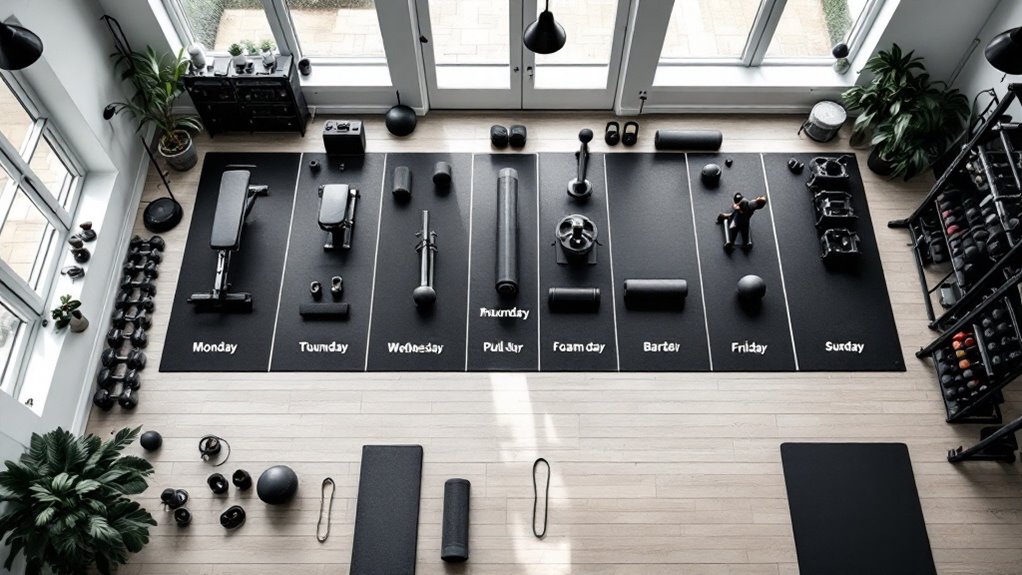Weekly Gym Plan

A strategic weekly gym plan combines three to four strength training sessions with cardiovascular work and recovery days. Monday focuses on chest and triceps, Tuesday targets back and biceps, Thursday emphasizes shoulders and legs, while Friday allows for full-body circuits. Active recovery and cardio sessions fill mid-week and weekend slots, with Sunday reserved for complete rest. Progress tracking guarantees continuous improvement as athletes advance from foundational movements to specialized training splits. Understanding proper exercise sequencing reveals maximum fitness potential.
Key Takeaways
- Schedule three to four strength training sessions per week, focusing on different muscle groups each day for balanced development.
- Include designated rest days and active recovery sessions to prevent burnout and promote muscle repair.
- Structure workouts with compound exercises first, followed by isolation movements to maximize strength and muscle gains.
- Track progress by recording weights, sets, and reps to ensure consistent improvement and identify areas needing adjustment.
- Incorporate both cardio and strength training throughout the week to improve overall fitness and maintain heart health.

A well-structured weekly gym plan serves as the foundation for achieving fitness goals and maintaining consistency in physical training. The key to success lies in strategic organization, proper exercise selection, and balanced intensity across different workout days. Like a military operation, each training session must have a clear objective and contribute to the overall mission of physical improvement.
The ideal weekly plan typically incorporates three to four strength training sessions, interspersed with cardiovascular work and adequate recovery periods. Monday often starts with compound movements focusing on the chest and triceps, mirroring the traditional "International Chest Day" culture while building momentum for the week ahead.
Tuesday redirects focus to back and biceps, targeting the pulling muscles that counterbalance the previous day's pushing movements. After a mid-week active recovery session involving light cardio or mobility work, Thursday becomes dedicated to shoulder and leg training. This combination enhances the body's natural hormone response, as leg exercises like squats and deadlifts trigger significant growth hormone and testosterone release.
Friday rounds out the strength training with a full-body circuit or specific focus on lagging body parts. Weekend sessions emphasize cardiovascular endurance and recovery. Saturday might include high-intensity interval training (HIIT) or steady-state cardio, while Sunday becomes sacred rest time – the body's opportunity to rebuild and prepare for the coming week's challenges.
Like a successful business strategy, this plan creates multiple streams of fitness benefits: strength, endurance, flexibility, and recovery. Tracking progress becomes paramount, treating each workout like a mission debrief. Recording weights, repetitions, and perceived exertion helps identify patterns and areas for improvement.
This data-driven approach, combined with progressive overload principles, guarantees continuous advancement toward fitness objectives. The journey transforms from a simple gym routine into a disciplined practice of self-improvement, where each week builds upon the previous one's achievements, creating a sustainable path toward peak physical condition. While experienced athletes might benefit from specialized training splits, full body workouts are particularly effective for beginners building foundational strength.
Frequently Asked Questions
How Long Should I Wait Between Sets During Weight Training?
Rest periods between weight training sets typically range from 30 seconds to 3 minutes, depending on training goals.
Muscle building requires 60-90 seconds, while strength training demands 2-3 minutes for ideal recovery.
Endurance work uses shorter 30-second breaks.
The body needs this time to replenish energy systems and clear metabolic waste.
Proper rest prevents form breakdown and reduces injury risk.
Should I Do Cardio Before or After Strength Training?
Like a strategic military operation, the sequence of cardio and strength training can determine victory or defeat.
For ideal results, performing strength training first allows the body to utilize stored glycogen for intense lifting. Cardio is best done afterward when energy systems are primed.
This approach amplifies muscle growth and strength gains while still achieving cardiovascular benefits. Those prioritizing fat loss may occasionally reverse this order.
What Should I Eat Before and After My Gym Workouts?
Pre-workout nutrition should include complex carbs and lean protein 2-3 hours before exercise – options like oatmeal with banana, whole grain toast with eggs, or Greek yogurt with berries.
Post-workout, consume protein within 30 minutes to support muscle recovery – lean meats, protein shakes, or tuna with complex carbs like sweet potatoes or quinoa to replenish glycogen stores.
Stay hydrated throughout.
How Can I Prevent Muscle Soreness After Intense Gym Sessions?
Studies show that 95% of athletes experience delayed onset muscle soreness (DOMS) at some point in their training.
To prevent post-workout muscle soreness, one should implement proper warm-ups, gradual progressive overload, and adequate hydration.
Post-workout recovery techniques like foam rolling, light stretching, and contrast therapy can help.
Getting 7-9 hours of sleep and consuming protein-rich foods also greatly reduces muscle soreness.
Is It Better to Exercise in the Morning or Evening?
Both morning and evening workouts offer distinct advantages.
Morning exercise boosts metabolism, improves mental focus, and promotes better sleep patterns. It also increases consistency since fewer scheduling conflicts arise.
Evening workouts benefit from higher body temperature, increased muscle strength, and improved performance due to accumulated energy from daily meals.
The best time ultimately relies on individual schedules, energy levels, and long-term adherence potential.
Final Thoughts
A well-structured weekly gym plan transforms wishful thinking into measurable progress. Research shows that individuals who follow organized fitness routines are 42% more likely to achieve their goals than those who exercise randomly. By implementing progressive overload, targeted nutrition, and adequate rest periods, anyone can optimize their fitness journey. The key lies in commitment, consistency, and the courage to begin, regardless of starting point.


